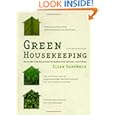Insulation: First the Body, Then the Home
Sunday, March 13th, 2011By Christa

In light of last month’s post about lowering the thermostat to lose weight, I was totally jazzed to happen upon a really fascinating article about how clothing impacts comfort indoors in Low-Tech Magazine.
There is another way to reduce energy consumption for space heating that does not have any of these disadvantages: lowering the thermostat and putting on more clothes. Although room temperature is hardly ever mentioned as a factor in energy use, it is a decisive factor in the energy consumption of heating systems…The insulating properties of clothing can be expressed in “clo”-units, where one “clo” equals the thermal insulation required to keep a resting person (for instance, a couch potato) indefinitely comfortable at a temperature of 21° Celsius (70° Fahrenheit)…The clo is an interesting unit because it allows us to precisely calculate which clothes we have to wear to feel comfortable at any given indoor temperature. According to the “Encyclopedia of occupational health and safety”, the required clo-value to maintain a neutral thermal sensation rises to about 2.7 at an indoor temperature of 10° Celsius (50°F). When the indoor temperature drops to 0° C (32°F), the required thermal insulation rises to 4 clo…The energy savings potential of clothing is so large that it cannot be ignored – though in fact this is exactly what is happening now. This does not mean that home insulation and efficient heating systems should not be encouraged. All three paths should be pursued, but improving clothing insulation is obviously the cheapest, easiest and fastest way.
I don’t know about you, but it’s nice to hear some advocating the wearing of a little more clothing over jacking the thermostat. Particularly since I’ve got myself pretty well trained to reach for another layer when I feel a chill instead of bumping the numbers. Now that I read the article I linked, I’m really excited to get some awesome high-tech, slim-fitting thermal gear for next winter. What about you? Are you rocking the long undies?
Neckwarmer by Cushy Company







